Mon, Jan 14, 2019
Final Rule Becomes Effective January 22
The FAA has eliminated the requirement for operators to apply for an RVSM (Reduced Vertical Separation Minimum) authorization when their aircraft are equipped with qualified ADS-B Out systems and meet specific altitude-keeping equipment requirements for operations in RVSM airspace.

On Dec. 21, 2018, the FAA issued a final rule effective on Jan. 22, 2019, revising the FAA's requirements for application to operate in RVSM airspace. The amendment eliminates the requirement for operators to apply for an RVSM authorization when their aircraft are equipped with qualified ADS-B Out systems and meet specific altitude-keeping equipment requirements for operations in RVSM airspace. This action recognizes the enhancements in aircraft monitoring resulting from the use of ADS-B Out systems and responds to requests from operators to eliminate the burden and expense of the current RVSM application process for aircraft equipped with qualified ADS-B Out systems.
The final rule makes significant and beneficial changes to 14 CFR Part 91 Appendix G to Part 91-Operations in Reduced Vertical Separation Minimum (RVSM) Airspace. While the entire revision should be reviewed, there are two areas to highlight. Section 2. Aircraft Approval was amended to recognize the addition of a new Section 9. Aircraft Equipped with Automatic Dependent Surveillance-Broadcast Out. Section 2 paragraph (a) now reads:
"Except as specified in Section 9 of this appendix, an operator may be authorized to conduct RVSM operations if the administrator finds that its aircraft comply with this section."
The new Section 9 in its entirety reads as follows:
Section 9. Aircraft Equipped with Automatic Dependent Surveillance-Broadcast Out. An operator is authorized to conduct flight in airspace in which RVSM is applied provided:
(a) The aircraft is equipped with the following:
(1) Two operational independent altitude measurement systems.
(2) At least one automatic altitude control system that controls the aircraft altitude-
(i) Within a tolerance band of ±65 feet about an acquired altitude when the aircraft is operated in straight and level flight under nonturbulent, nongust conditions; or
(ii) Within a tolerance band of ±130 feet under nonturbulent, nongust conditions for aircraft for which application for type certification occurred on or before April 9, 1997, that are equipped with an automatic altitude control system with flight management/performance system inputs.
(3) An altitude alert system that signals an alert when the altitude displayed to the flightcrew deviates from the selected altitude by more than-
(i) ±300 feet for aircraft for which application for type certification was made on or before April 9, 1997; or
(ii) ±200 feet for aircraft for which application for type certification is made after April 9, 1997.
(4) A TCAS II that meets TSO C-119b (Version 7.0), or a later version, if equipped with TCAS II, unless otherwise authorized by the administrator.
(5) Unless authorized by ATC or the foreign country where the aircraft is operated, an ADS-B Out system that meets the equipment performance requirements of § 91.227 of this part. The aircraft must have its height-keeping performance monitored in a form and manner acceptable to the administrator.
(b) The altimetry system error (ASE) of the aircraft does not exceed 200 feet when operating in RVSM airspace.
The AEA is encouraged with the FAA's recognition of modern technology and the elimination of unnecessary administrative burden when the aircraft is properly equipped and maintained by professional technicians.
AEA member companies servicing aircraft that operate in RVSM airspace are encouraged to download and become familiar with the entire revision. In addition, shops are encouraged to share this significant rulemaking with their customers.
(Source: AEA news release)
More News
Also: B-29 Superfortress Reunion, FAA Wants Controllers, Spirit Airlines Pulls Back, Gogo Galileo Van's Aircraft posted a short video recapping the goings-on around their reorganiz>[...]
Light Gun A handheld directional light signaling device which emits a brilliant narrow beam of white, green, or red light as selected by the tower controller. The color and type of>[...]
"The journey to this achievement started nearly a decade ago when a freshly commissioned Gentry, driven by a fascination with new technologies and a desire to contribute significan>[...]
"Our driven and innovative team of military and civilian Airmen delivers combat power daily, ensuring our nation is ready today and tomorrow." Source: General Duke Richardson, AFMC>[...]
Aircraft Conflict Predicted conflict, within EDST of two aircraft, or between aircraft and airspace. A Red alert is used for conflicts when the predicted minimum separation is 5 na>[...]
 Airborne 04.16.24: RV Update, Affordable Flying Expo, Diamond Lil
Airborne 04.16.24: RV Update, Affordable Flying Expo, Diamond Lil ANN's Daily Aero-Term (04.20.24): Light Gun
ANN's Daily Aero-Term (04.20.24): Light Gun Aero-News: Quote of the Day (04.20.24)
Aero-News: Quote of the Day (04.20.24) Aero-News: Quote of the Day (04.21.24)
Aero-News: Quote of the Day (04.21.24) ANN's Daily Aero-Term (04.21.24): Aircraft Conflict
ANN's Daily Aero-Term (04.21.24): Aircraft Conflict



